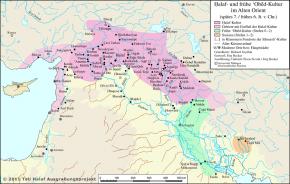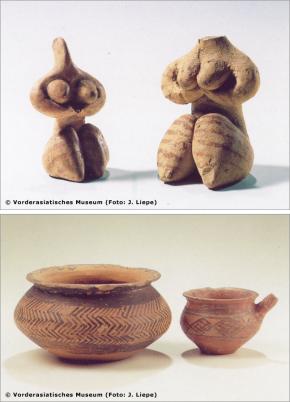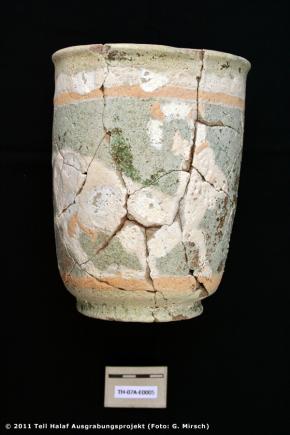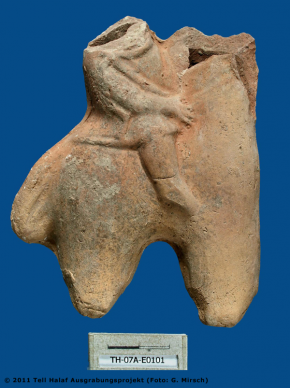Periods of occupationDr. Jörg Becker/Prof. Dr. Mirko Novák/Elisabeth Katzy, M.A.The prehistoric settlement at Tell Halaf
(7th–4th millennium B.C.–Neolithic and Chalcolithic ages)
Tell Halaf is the eponymous site for the late Neolithic Halaf culture that derives from older ancestors within the Pottery Neolithic period. This agricultural, village-based culture expanded across the entire northern Mesopotamian landscape – the northern part of the «fertile crescent» – between ca. 6000–5300 B.C. (Fig. 1).
The early excavations at Tell Halaf, conducted by Max von Oppenheim, produced great amounts of typical painted pottery and other objects (seals, terracotta-figurines, etc.) from the Halaf period (Fig. 2). However, the excavators were not able to identify the structures within the prehistoric debris. The fact that typical round buildings were the primary living and working areas during the Halaf period complicated matters. Rarely occurring rectangular buildings usually functioned as storage-facilities. This means, when excavating, one has to think in round structures as well. The primary goals of the investigations of the prehistoric levels are:
- Working out a more detailed stratigraphy
- To excavate these buildings on a larger scale by levels of settlement
- In addition to the assessment of pottery, artifacts, animal bones and botanic remains, which offer crucial evidence for subsistence (relation between agriculture, animal husbandry and hunting), the social development of the site is to be investigated over a period of about 3000 years and to be set into its cultural and historical context. Iron Age
The Bronze Age (3000–1200 B.C.) yielded only very few artifacts, so that we may presume that occupation activities had moved to near-by Tell Fecheriye (http://www.fecheriye.de/). Tell Halaf was not resettled before the beginning of the Iron Age. Single sherds of the hand-made, Anatolian «Groovy Pottery» indicate that eastern Anatolian immigrants had established a settlement on the site during the Early Iron Age (1200–1000 B.C.). From the 13th century B.C. onwards, Mesopotamian and Syrian sources give evidence of the successive immigration of Aramaean nomads. Around 1000 B.C. they founded a number of smaller principalities in Syria and Mesopotamia. One of them was Guzana, the capital of the principality of Bit-Bakhiani, rediscovered in Tell Halaf. Of the early Aramaean rulers, only few are known by name: among these, especially Kapara merits our interest. At the turn of the 10th to the 9th century B.C., he commissioned the Hilani known as the «West Palast» and the neighbouring «Skorpionentor». Aside from paying tribute to kings like Tukulti-Ninurta II (890–884 B.C.) and Ashurnasirpal II (883–859 B.C.), the Aramaean states obviously remained fairly autonomous. At that time, Adad-it´i ruled in Guzana. His statue with a bilingual inscription in Assyrian and Aramaean was found at Tell Fecheriye. Following an insurrection in 808 B.C., Guzana was conquered by Adad-nirari III (810–783 B.C.) and obviously incorporated into the Assyrian empire for good (Fig. 3-4). In 793 B.C., Mannu-ki-mat-Assur, whose administrative archive was found in Tell Halaf, was the first governor of Guzana to hold the eponym office in Assyria. The town remained part of the Assyrian empire until the latter’s collapse between 612 and 609 B.C. Hellenistic and later periods
The site remained settled during the Hellenistic period. Ptolemy (ca. 100–175 A.D.) calls the landscape Gauzanitis. The research on the Hellenistic period at Tell Halaf shows that, from the beginning of the Seleucid empire (end of the 4th up until the 2nd century B.C.) onwards, the town belonged to the Seleucid sphere of influence under the regional centre Antiocheia Kallirhoe (Edessa). After the founding of the principality of Edessa/Osrohene in 133/2 B.C. it remained in the sphere of influence of this city, which was now controlled by the Parthians until the beginning of the 1st century B.C. The recovered objects (i.e. pottery, artifacts and coins) from the new and old excavations support these facts. At the end of the 1st century B.C. the town was slowly abandoned. This was probably caused by a shift in settlement to close-by Tell Fecheriye (Fig. 5-6).. In the Islamic Middle Ages, a small settlement existed on Tell Halaf. But at the time of Max von Oppenheim's excavation the surroundings of the site were occupied by nomads, only. The modern village of Tell Halaf came into being in the 1970’s, when Arab peasants were relocated from the areas of the Euphrates valley, that were to be submerged by the Tabqa reservoir. (Translation: B. Finkbeiner / A. Sollee / B. Sollee) Chronology
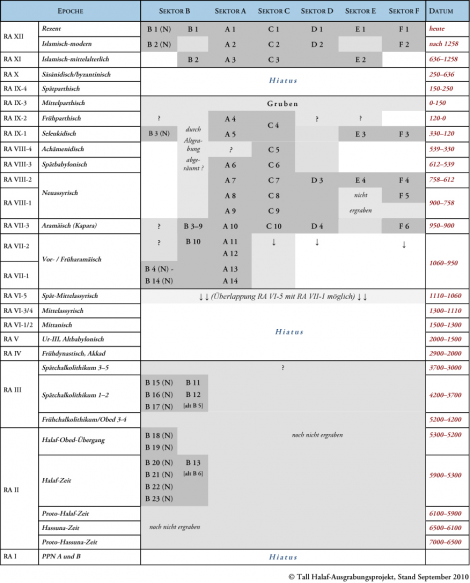 |






